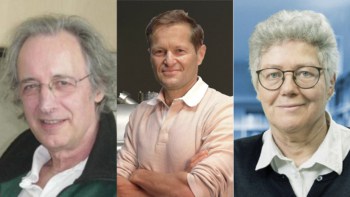
A new kind of camera that does not form a physical image has been developed by scientists in the US. Employing just a single sensor and an array of apertures rather than a lens, the device can acquire the image of a scene using fewer measurements than conventional cameras. According to its inventors, it would be particularly good for surveillance operations and could also be adapted for non-visible imaging at wavelengths such as infrared, millimetre-wave and terahertz.
Conventional cameras use a lens to project an image onto photographic film or an array of charge-coupled devices. What Paul Wilford and colleagues of Alcatel-Lucent’s Bell Labs in New Jersey have instead done is to use a single point-like sensor to record the intensity of light that has passed through an array of tiny apertures placed between the object and the sensor. The researchers essentially create an image in time instead of space and do so using just a fraction of the measurements needed in normal digital cameras.
One aperture at a time
Each of the apertures in the array can be independently opened and closed using a computer. The simplest way to record an image is to open one aperture at a time, measuring the intensity of the light arriving at the sensor that has bounced off the object and passed through just that aperture. The number of required measurements is therefore the number of apertures, with the process equivalent to building up an image from a pinhole camera one pixel at a time.
Instead of using this simple method, the team uses an established signal-processing technique known as compressive sensing to reduce the amount of data needed to reconstruct an image. Wilford and colleagues do this by generating pseudo-random patterns of open and closed apertures within the array. Rather than measuring the intensity of light passing through one aperture at a time, the combined intensity from all of the apertures (open and closed) is measured. It then generates another pseudo-random pattern and measures the light transmitted by that, and so on.
“The pseudo-random patterns of the apertures make it possible to capture the information from the scene with a reduced number of measurements,” explains Wilford.
LCD apertures
The team built its aperture array from a monochrome liquid-crystal display (LCD) comprising some 65,000 squares that can be made either transparent or opaque. The sensor is a single pixel from a photovoltaic sensor that records the intensity of red, blue and green light falling on it. The research group enclosed the array and sensor inside a light-tight box about the size of a small microwave oven and used a computer to generate the aperture patterns and synchronize this pattern generation with the recording of the intensity measurements. These measurements were then converted into images in a separate step.

The researchers imaged a football, a pile of books and a toy sleeping cat, and found that they could generate reasonable images of these objects using just a quarter (or in the case of the football an eighth) of the measurements that would be needed using a conventional camera. They also imaged the books using two sensors in different positions at the same time, showing how multiple sensors can be used either to reduce the time needed to capture an image or to improve its resolution.
According to Wilford, the device has a number of advantages over conventional cameras. The absence of a lens, he says, potentially makes it cheaper, lighter and free of distortions, with the image quality in theory only limited by the resolution of the aperture array. He adds that the device could be used for low-power imaging, since only a fraction of the data is collected at source and no processing is required to compress the image. The camera would be particularly well suited to surveillance, where the aim is to record changes in a scene and not to make detailed images of it. Wilford adds that it might also be used for imaging at different wavelengths where sensors are expensive.
Technical hurdles
However, the team acknowledges that it must overcome a number of technical hurdles before commercializing its device. The main one is speed. Limited by the working frequency of the LCD display and the sensor’s response time, one picture takes between several minutes and an hour to acquire. Boosting the frequency will mean making the apertures much smaller if energy consumption is to be kept under control. One option, according to Wilford, is to use microelectromechanical systems (MEMs) – moving devices built from components measuring as little as microns across.
Tiny, fast-moving apertures introduce a new problem – how to collect enough light in each measurement to create an image. A rival team at Rice University in Texas has made a similar device but has used lenses both to focus the light from an object onto an aperture array and then to direct the outgoing light on to a single-pixel sensor. Wilford admits that increasing the signal-to-noise ratio of his group’s sensor to the point where it can cope with the aperture speeds needed to produce videos will be “a challenge”, but underlines his group’s desire to “get away from this idea of creating a physical image”. “We face a number of practical issues,” he says, “but this is not by any means outside the realm of today’s technology.”
The camera is described in two preprints on the arXiv server (arXiv:1306.3946 and arXiv:1305.7181).



